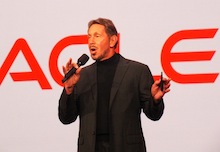Oracle expands cloud services; unveils world's 'first' multi-tenant database


SAN FRANCISCO -- Oracle Corporation CEO Larry Ellison took to the stage to unveil the tech giant's "new approach" to engineering hardware and software together on the opening night of Oracle OpenWorld 2012 on Sunday evening.
See also: Oracle OpenWorld 2012: By the numbers
Oracle unveils public cloud partner programs
As promised during the most recent quarterly conference call with investors, Ellison introduced four new major services, starting off with a third tier to the Oracle Cloud: Infrastructure-as-a-Service.
"Our customers running our SaaS and PaaS solutions, they need to run certain kinds of custom applications and move some of their existing apps onto the cloud as well," Ellison said. "The only way we can accommodate that is offer infrastructure-as-a-serivce in addition to SaaS and PaaS."
The Oracle Cloud IaaS will be sold on Oracle's engineered systems: Exadata, Exalogic, and SuperCluster while running on an Infiniband network.
Ellison stressed the point that with Oracle Cloud, the global tech giant is adding a new line of business to its traditional lines of business of selling hardware and software.
To put this into perspective, Oracle specified that Amazon.com -- not IBM -- is the "primary competitor" with this solution. Ellison also cited that this bumps up Oracle's tiers of cloud service to three, declaring that Amazon only has one while Salesforce.com has two.
The second major announcement was the Oracle Private Cloud, an extension to the Oracle Cloud behind the customer's firewall.
Oracle owns and manages the infrastructure, running on Exalogic, Exadata and SuperCluster. The infrastructure is installed in the customer's data center behind the company's firewall. The customer then pays a monthly service fee based on usage with excess capacity installed and available on demand.
The Oracle Private Cloud will run all Oracle software along with customer applications. This includes support for the E-Business suite, PeopleSoft and Siebel as well as the Oracle Database and Fusion Middleware.
"The Oracle Private Cloud is quite literally an extension of the Oracle Cloud," Ellison asserted. "You can't tell the difference."
Thus, customers should be able to move applications back-and-forth between both cloud platforms, using the Oracle Cloud to develop and test while running on the Private Cloud. Furthermore, customers can use Oracle Cloud for backup and implement disaster recovery on the Private Cloud. Ellison described that they are essentially "interchangeable."
The third announcement was the Oracle Database 12c, the "first multi-tenant database" in the world for the cloud, which Ellison noted was in development for more than four years.
"We needed a new foundation to support modern cloud applications," Ellison remarked. "We did a lot of work to improve our middleware to support our SaaS applications."
Described as the "software foundation of the Oracle Cloud," the multi-tenant pluggable database architecture consists of the memory, processes, and storage of multiple databases all consolidated into one container database. Ellison stressed that this combines all the benefits of multi-tenancy as well as hardware and operational efficiencies without any change to the application at all.
"These pluggable databases are vastly more efficient than traditional databases," Ellison argued, citing that they use six time less hardware resources while running five times more databases. For example, that equates to only 3GB of memory versus 20GB of memory used for 50 databases.
Most important, Ellison cited, was that with multi-tenancy implemented at the database level, that combines security with efficiency.
"Each customer's data is safe in a separate, private database," Ellison explained, noting that all of the database security features work, such as auditing, reporting, and redaction. He said that these normally don't work in multi-tenant databases.
As for the hardware foundation, Ellison announced Exadata X3, a database in-memory machine, which was designed to store all of a customer's databases in-memory.
Exadata X3 consists of 26 terabytes of DRAM and flash in a single rack. Flash memory is being increased by a factor of four, but Ellison stressed that pricing will remain the same.
To really emphasize just how powerful X3 is, Ellison declared that it would take 100 racks of disk drives to do the same amount of input and output as one rack of Exadata X3.
Ellison did pull out a comparison to IBM at this point, highlighting that the Exadata X3-2 Half Rack outperforms the IBM P780 database at an eighth of the price.
Concluding by declaring the Exadata X3 as the "world's fastest computer for business," the X3 starts for under $200,000.